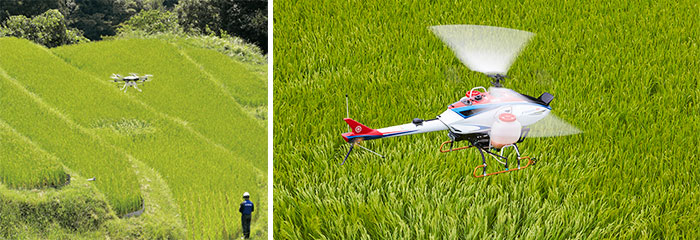Series Hybrid Core (Concept) : A Different Approach to Powering Drones
Introducing the development of Series Hybrid Core for drones.
The Issues Faced in Drone Use
The more prevalent use of drones has made unmanned aircraft a common sight in the skies today and they are widely claimed to be what will drive big changes in how we live our lives. Yamaha Motor’s work in the unmanned aircraft field began in the 1980s with the development of an industrial-use unmanned helicopter aimed at bringing greater automation and labor savings to Japan’s agriculture industry. Today, Yamaha’s helicopters play an important role in aerial crop dusting as well as professional surveying and surveillance operations.

Recent years have seen a rapid growth in drone use across a wide range of jobs, and battery-powered models are the mainstream choice due to their ease of operation and relatively low purchase and introduction cost. Another reason driving the spread of drones lies in the advantages provided by their electric motors, such as instant delivery of strong torque, excellent response and highly controllable power.
However, there are tasks that require a full day’s worth of flying and this inevitably entails battery swaps. This in turn means operating a drone comes with limitations that must be taken into account, such as a work environment where recharging can be done and allowances for charging time. In short, if you want longer range and flight time, you have to increase the capacity of the battery.
However, that will naturally make the battery bigger and heavier, introducing a new problem of adding onto the overall weight of the aircraft. This presents a dilemma for drones that fly only on the power of the battery and motor—enlarging the power source does not necessarily bring a proportionate increase in range, flight time and payload.
So, how you get that power becomes key.
Making the Engine the Power Source Instead of the Battery
For drones to realize their envisioned potential in the near future as essential parts of society in fields like logistics, infrastructure inspection, surveillance and disaster response, craft capable of longer flights with greater range and more power are prerequisites. Furthermore, if drones are to become an integral part of the infrastructure supporting work and people’s lives, thought must be given to the area a single drone can cover and the frequency of flights required.
Compared to today’s drones, a big leap in the efficiency of power supply schemes is needed.
That is why the advantages of internal combustion engines come to the fore. When comparing gasoline and a battery, the difference in energy intensity between the two is all too clear. However, if a gasoline engine is used not to power the aircraft to fly but to generate electricity instead, it becomes possible for the engine to run at an rpm range for maximum combustion efficiency, thereby compounding the effects of gasoline’s higher energy intensity and the improved fuel mileage to create a power source more efficient than a battery.
The benefits of a gasoline engine include taking far less time to refuel than it takes to recharge a battery and as long as a portable gasoline can is carried along to the worksite, the craft can be refueled then and there. Going forward, when considering that the need for drones is expected to grow in mountainous and rural areas and for transporting heavy materials over long distances, the advantages and possibilities presented by a series hybrid design, which uses a gasoline engine as its power source, cannot be ignored. From a technical standpoint, reaching this conclusion was only natural.


Reasons for Putting Forward a Series Hybrid Design
Yamaha Motor has the technology to develop lightweight, compact and highly reliable engines, and through our many years in the industrial-use unmanned helicopter business, we have acquired the knowledge and know-how for operating unmanned aircraft as well as built up the requisite aircraft servicing scheme and customer support network for real-world operations.
Besides drones, Yamaha also possesses technical expertise gained from developing a wide range of products for different fields powered by electric motors and their accompanying electronic control systems. Because we frequently learn of the issues users face when they are actually in the field, this helps lead us to identifying potential customer needs.
So, as a company with a wealth of technologies for and products using gasoline engines and electric motors alike, our proposal for a drone aircraft with a series hybrid electric vehicle (SHEV) powertrain—in which the engine is used not to propel the craft but to generate electricity for it—is backed by real-world experience, our approach to problem-solving and the technologies to achieve both.
Series Hybrid Core (Concept for Drones)

| Specification | |
|---|---|
| Engine rated power output (Generated energy) |
20.6kW (17.1kW) |
| Fuel used | Regular unleaded |
| Unit weight | approx. 70kg |
| Supply voltage | 300V |
| Max. continuous flight time | approx. 4 hours |
| Payload (incl. fuel) | approx. 25kg |
| Expected price | TBD |
- *
- These figures are from mid-development.
- *
- Items included with the unit: power-generating engine, battery (auxiliary power supply), inverter, wiring/cables